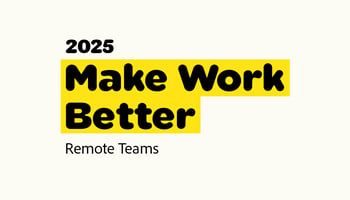Imagine if you only knew you were doing a good job at work when a gift card appeared.
Mastering Employee Recognition: Examples and Tips for a Successful Program
You think everyone at your company is pretty cool. Team appreciation messages are no biggie. You’ve never hesitated to write a thank you note to a colleague. So why implement a whole employee recognition program?
Because nothing lasts forever. One manager takes a harsher tone, one new hire doesn’t “get it” quickly enough for their coworkers, one cute company perk is cut for cost savings–it takes just one alteration to the environment to palpably feel morale drop.
Let’s get ahead of that. Today, HeyTaco is sharing a beginner’s overview of building a successful recognition program. From there, we’ve got a short list of popular employee recognition examples, topped off by a few secrets to putting everything into place lightning-quick.
What is an example of employee recognition?
Employee recognition is positive recognition. Examples include publicly praising someone, rewarding them, or having team celebrations.
A key point of employee recognition is that no gesture is too small. Thanking someone for fixing a spreadsheet is just as important as an Employee of the Month ceremony.
It also doesn’t only happen on a schedule. The goal of prioritizing recognition is to embed it into your company culture.
The essential components of an employee recognition program
An employee recognition program is a supportive structure to keep a supportive, positive culture together. Your needs will vary, but here are some basics to begin with.
1. Defining objectives and looping in leadership
How does employee recognition serve your company’s core values? Identify what the program needs to do beyond ensuring everyone is giving kudos. Examples may be something like, “Recognizing each employee’s unique strengths supports our commitment to innovation.”
Now we know that the program would include acknowledging an employee’s new ideas or creativity in finding solutions.
With a mission drafted, it’s crucial to get input and support from leadership. They are the ones who will play one of the largest roles in sustaining and growing a culture of recognition.
2. Choosing non-monetary rewards
When recognition programs are successful, more and more opportunities to reward employees arise. To keep the program sustainable, immediately start measuring the success of non-monetary rewards.
The goal is to avoid an environment where people essentially get paid extra to be nice. This isn’t authentic and it costs too much. A veneer of good morale and transactional engagement aren’t as beneficial as the real things.
3. Including all types of employee recognition
A diverse array of recognition types will make it easier for different personalities to engage daily. It will also prevent recognition from becoming rote or stale.
Employee recognition examples can be categorized into the following:
- Public acknowledgment
- Peer-to-peer recognition
- Personalized thank-you notes
- Employee of the Month
- Team celebrations
- Milestone celebrations
- Recognition walls
Wondering exactly what to say or do for each of these? We have 40 positive recognition examples broken down by occasion.
4. Keeping recognition personal and inclusive
Personalized recognition allows the employee to derive maximum motivation and good morale.
For instance, some employees won’t feel the full force of your appreciation unless they know everyone else knows it, too. That’s why you’d be sure to shout that employee out on social media or during a meeting. Meanwhile, others find private, handwritten congrats to be most meaningful.
Inclusivity helps ensure everyone is celebrated, but inclusivity for the sake of inclusion isn’t very impactful. Acknowledge a broader range of beneficial qualities. Instead of complimenting performance alone, be sure to recognize the person who is timely, comes in with a smile on their face, or is always first to try and help a coworker.
5. Remaining relevant with feedback
Communication and transparency matter greatly in employee recognition programs. Employees should know what the company’s mission is, how the program aligns with that, and how they can achieve goals like Employee of the Month.
Polls, surveys, or simply asking for feedback are solid ways to confirm that the program has the potential for success. It can also reveal the most popular forms of recognition, what team-building exercises could reinforce the results, and ways to personalize recognition in the future.
Plus, feedback is important recognition for employees, too. About 80% of employees report being more engaged and motivated when they receive regular feedback.
Popular employee recognition examples for morale and engagement
Honors, acclaim, credit, and kudos. Employee recognition examples can be adapted to teams of all sizes and in every workplace model. Here’s a rundown of the ones companies seem to have the most success with:
- Writing an appreciation note to a coworker
- Flexible work arrangements
- Providing training or mentorship
- Complimentary lunch or coffee break
- Verbal praise for specific behaviors/achievements
- Offering a wellness program for work-life balance
- Mentioning positive performance in newsletters or on social media
Get employee recognition off the ground in two simple steps
Hammering out the finer details of a grand plan is great, but what about today? Luckily, there are two easy steps to start moving the needle by the end of this week.
- Create a channel in your messaging platform (like Slack) for appreciation. Positive vibes of gratitude only.
- Use this channel to start making recognition part of your team meetings. Share the highlights and shout out the biggest contributors.
We discuss this in a bit more detail here: How to Start Building an Employee Recognition Program in 2 Simple and Free Steps.
Yes, the best part is that it’s free! In fact, even if you choose to make it even easier with an exceptional, award-winning, globally beloved employee recognition tool, it’s still free.











